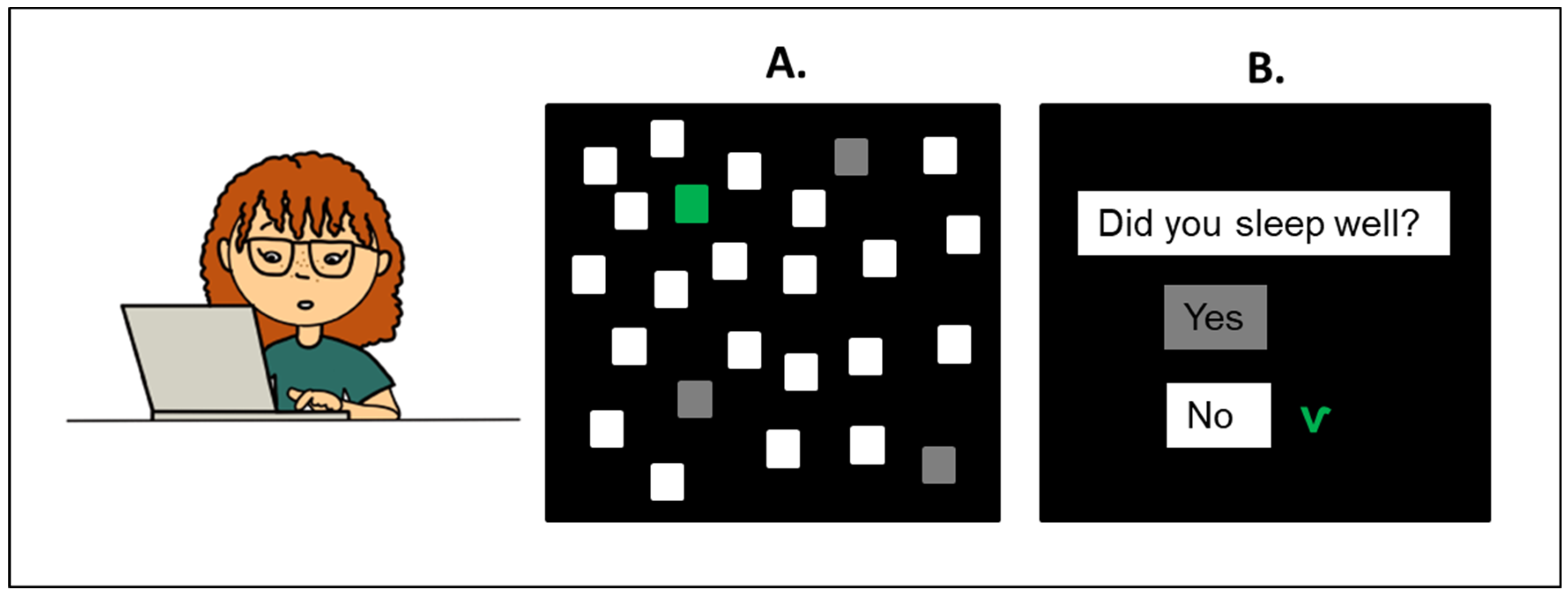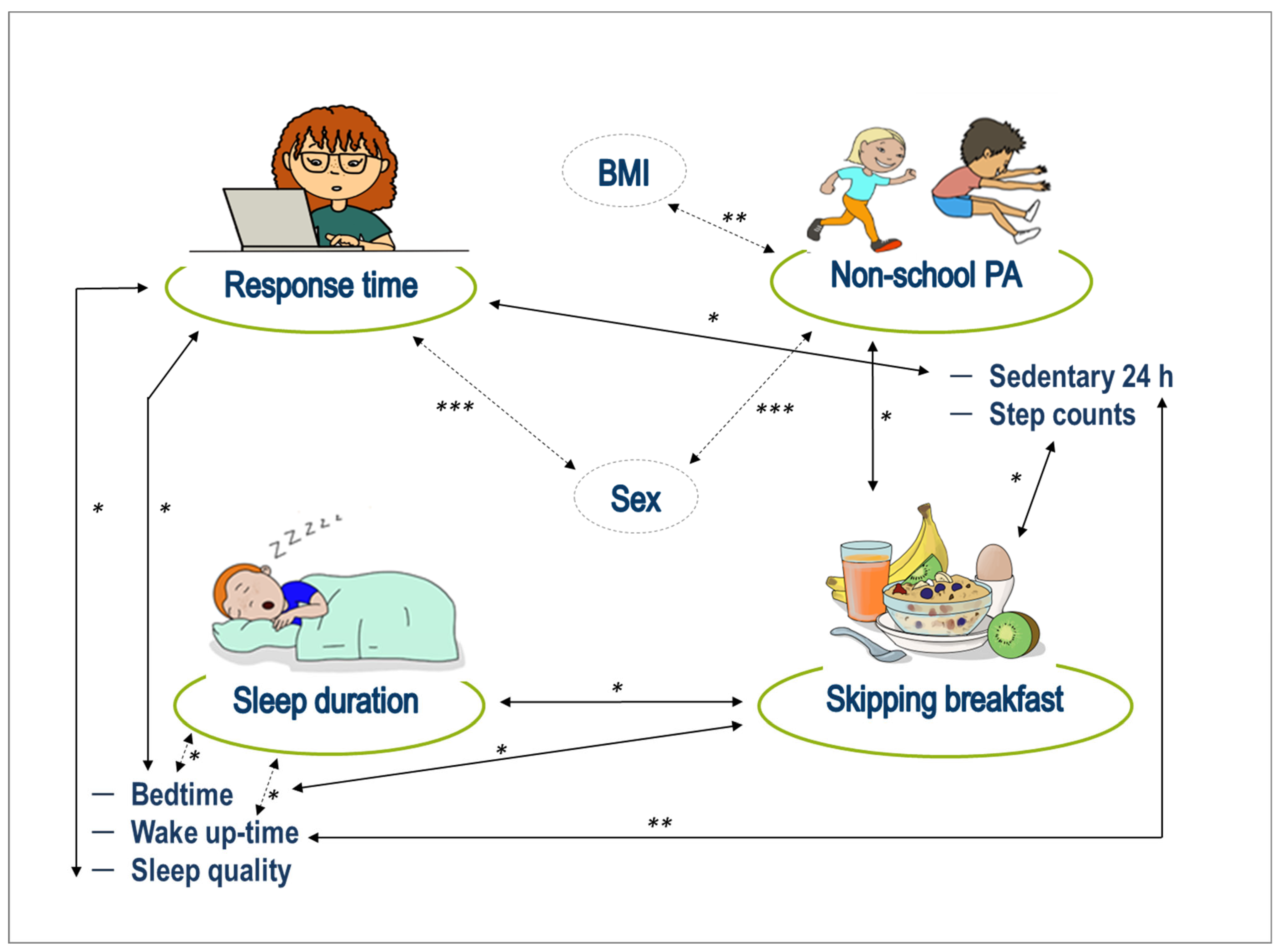Unfavorable Behaviors in Children Run in Packs! Dietary and Non-Dietary Modulators of Attentional Capacity
Abstract
1. Introduction
2. Methods
2.1. Study Design and Recruitment
2.2. Study Schedule and Participants
2.3. Cognitive Assessment
2.4. Statistical Analyses
3. Results
3.1. Differences between Boys and Girls
3.2. Breakfast Habits
3.3. Visual Attention Task
4. Discussion
Limitations
5. Conclusions
Author Contributions
Funding
Institutional Review Board Statement
Informed Consent Statement
Data Availability Statement
Acknowledgments
Conflicts of Interest
References
- Han, S.H.; Yee, J.Y.; Pyo, J.S. Impact of Short Sleep Duration on the Incidence of Obesity and Overweight among Children and Adolescents. Medicina 2022, 58, 1037. [Google Scholar] [CrossRef] [PubMed]
- Adolphus, K.; Lawton, C.L.; Champ, C.L.; Dye, L. The Effects of Breakfast and Breakfast Composition on Cognition in Children and Adolescents: A Systematic Review. Adv. Nutr. 2016, 7, 590S–612S. [Google Scholar] [CrossRef]
- Warren, C.; Riggs, N.; Pentz, M.A. Executive Function Mediates Prospective Relationships between Sleep Duration and Sedentary Behavior in Children. Prev. Med. 2016, 91, 82–88. [Google Scholar] [CrossRef] [PubMed]
- Haug, E.; Rasmussen, M.; Samdal, O.; Iannotti, R.; Kelly, C.; Borraccino, A.; Vereecken, C.; Melkevik, O.; Lazzeri, G.; Giacchi, M.; et al. Overweight in School-Aged Children and Its Relationship with Demographic and Lifestyle Factors: Results from the WHO-Collaborative Health Behaviour in School-Aged Children (HBSC) Study. Int. J. Public Health 2009, 54 (Suppl. 2), 167–179. [Google Scholar] [CrossRef]
- Robinson, T.N.; Banda, J.A.; Hale, L.; Lu, A.S.; Fleming-Milici, F.; Calvert, S.L.; Wartella, E. Screen Media Exposure and Obesity in Children and Adolescents. Pediatrics 2017, 140, S97–S101. [Google Scholar] [CrossRef] [PubMed]
- Vereecken, C.; Dupuy, M.; Rasmussen, M.; Kelly, C.; Nansel, T.R.; Al Sabbah, H.; Baldassari, D.; Jordan, M.D.; Maes, L.; Niclasen, B.V.L.; et al. Breakfast Consumption and Its Socio-Demographic and Lifestyle Correlates in Schoolchildren in 41 Countries Participating in the HBSC Study. Int. J. Public Health 2009, 54 (Suppl. 2), 180–190. [Google Scholar] [CrossRef] [PubMed]
- Sina, E.; Boakye, D.; Christianson, L.; Ahrens, W.; Hebestreit, A. Social Media and Children’s and Adolescents’ Diets: A Systematic Review of the Underlying Social and Physiological Mechanisms. Adv. Nutr. 2022, 13, 913–937. [Google Scholar] [CrossRef] [PubMed]
- López-Gil, J.F.; Sánchez-Miguel, P.A.; Tapia-Serrano, M.Á.; García-Hermoso, A. Skipping Breakfast and Excess Weight among Young People: The Moderator Role of Moderate-to-Vigorous Physical Activity. Eur. J. Pediatr. 2022, 181, 3195–3204. [Google Scholar] [CrossRef] [PubMed]
- Paruthi, S.; Brooks, L.J.; D’Ambrosio, C.; Hall, W.A.; Kotagal, S.; Lloyd, R.M.; Malow, B.A.; Maski, K.; Nichols, C.; Quan, S.F.; et al. Consensus Statement of the American Academy of Sleep Medicine on the Recommended Amount of Sleep for Healthy Children: Methodology and Discussion. J. Clin. Sleep Med. 2016, 12, 1549–1561. [Google Scholar] [CrossRef]
- Carter, K.A.; Hathaway, N.E.; Lettieri, C.F. Common Sleep Disorders in Children. Am. Fam. Physician 2014, 89, 368–377. [Google Scholar]
- Scapaticci, S.; Neri, C.R.; Marseglia, G.L.; Staiano, A.; Chiarelli, F.; Verduci, E. The Impact of the COVID-19 Pandemic on Lifestyle Behaviors in Children and Adolescents: An International Overview. Ital. J. Pediatr. 2022, 48, 22. [Google Scholar] [CrossRef]
- Drozdowska, A.; Jendrusch, G.; Platen, P.; Lücke, T.; Kersting, M.; Sinningen, K. Cross-Sectional Association Between Level of School Sports and Different Cognitive Parameters in Schoolchildren, Considering Multiple Covariates. Mind Brain Educ. 2022, 16, 139–148. [Google Scholar] [CrossRef]
- DeCosta, P.; Møller, P.; Frøst, M.B.; Olsen, A. Changing Children’s Eating Behaviour—A Review of Experimental Research. Appetite 2017, 113, 327–357. [Google Scholar] [CrossRef] [PubMed]
- Schlieber, M.; Han, J. The Role of Sleep in Young Children’s Development: A Review. J. Genet. Psychol. 2021, 182, 205–217. [Google Scholar] [CrossRef] [PubMed]
- Liu, A.; Fan, J.; Ding, C.; Yuan, F.; Gong, W.; Zhang, Y.; Song, C.; Zhou, Y.; Ding, G. The Association of Sleep Duration with Breakfast Patterns and Snack Behaviors among Chinese Children Aged 6 to 17 Years: Chinese National Nutrition and Health Surveillance 2010–2012. Nutrients 2022, 14, 2247. [Google Scholar] [CrossRef]
- Said, M.A.; Shaab Alibrahim, M. Physical Activity, Sedentary Behaviors, and Breakfast Eating as Factors Influencing BMI in Saudi Students, Aged 10 to 15 Years. Ann. Med. 2022, 54, 1459–1472. [Google Scholar] [CrossRef]
- Chen, S.; Zhang, X.; Du, W.; Fan, L.; Zhang, F. Association of Insufficient Sleep and Skipping Breakfast with Overweight/Obesity in Children and Adolescents: Findings from a Cross-Sectional Provincial Surveillance Project in Jiangsu. Pediatr. Obes. 2022, 17, e12950. [Google Scholar] [CrossRef]
- Drozdowska, A.; Falkenstein, M.; Jendrusch, G.; Platen, P.; Luecke, T.; Kersting, M.; Jansen, K. Water Consumption during a School Day and Children’s Short-Term Cognitive Performance: The CogniDROP Randomized Intervention Trial. Nutrients 2020, 12, 1297. [Google Scholar] [CrossRef]
- Drozdowska, A.; Falkenstein, M.; Jendrusch, G.; Platen, P.; Lücke, T.; Kersting, M.; Sinningen, K. Interrelations of Physical Fitness and Cognitive Functions in German Schoolchildren. Children 2021, 8, 669. [Google Scholar] [CrossRef]
- Shimizu, H.; Yoon, S.; McDonough, C.S. Teaching Skills to Use a Computer Mouse in Preschoolers with Developmental Disabilities: Shaping Moving a Mouse and Eye-Hand Coordination. Res. Dev. Disabil. 2010, 31, 1448–1461. [Google Scholar] [CrossRef]
- Naido, R.; Salkind, N.J. Effect of Input Devices on Eye-Hand Coordination in Young Children. Percept. Mot. Skills 1990, 70, 984–986. [Google Scholar] [CrossRef] [PubMed]
- Sandercock, G.R.H.; Voss, C.; Dye, L. Associations between Habitual School-Day Breakfast Consumption, Body Mass Index, Physical Activity and Cardiorespiratory Fitness in English Schoolchildren. Eur. J. Clin. Nutr. 2010, 64, 1086–1092. [Google Scholar] [CrossRef] [PubMed]
- Liu, S.; Yu, Q.; Li, Z.; Cunha, P.M.; Zhang, Y.; Kong, Z.; Lin, W.; Chen, S.; Cai, Y. Effects of Acute and Chronic Exercises on Executive Function in Children and Adolescents: A Systemic Review and Meta-Analysis. Front. Psychol. 2020, 11, 554915. [Google Scholar] [CrossRef] [PubMed]
- Badrasawi, M.; Anabtawi, O.; Al-Zain, Y. Breakfast Characteristics, Perception, and Reasons of Skipping among 8th and 9th-Grade Students at Governmental Schools, Jenin Governance, West Bank. BMC Nutr. 2021, 7, 42. [Google Scholar] [CrossRef]
- Doan, N.; Parker, A.; Rosati, K.; van Beers, E.; Ferro, M.A. Sleep Duration and Eating Behaviours among Adolescents: A Scoping Review. Health Promot. Chronic Dis. Prev. Canada Res. Policy Pract. 2022, 42, 384–397. [Google Scholar] [CrossRef]
- Tremolada, M.; Taverna, L.; Bonichini, S. Which Factors Influence Attentional Functions? Attention Assessed by KiTAP in 105 6-to-10-Year-Old Children. Behav. Sci. 2019, 9, 7. [Google Scholar] [CrossRef]


| Boys | Girls | p Value | |
|---|---|---|---|
| n (%) | 142 (63.7) | 81 (36.3) | |
| Grade 5 | 67 | 34 | |
| Grade 6 | 75 | 47 | |
| BMI | 20.1 ± 4.8 | 20.4 ± 4.3 | 0.283 |
| Sleep | |||
| Duration, hours | 9:15 ± 1:14 | 9:10 ± 1:26 | 0.691 |
| Poor sleep quality, n (%) | 13 (9.2) | 8 (10.0) | 0.817 |
| Bedtime | 20:47 | 20:55 | 0.596 |
| Wake up-time | 06:17 | 06:12 | 0.203 |
| Breakfast | |||
| Had a full breakfast, n (%) | 92 (65.2) | 43 (53.8) | 0.087 |
| Skipping breakfast at all, n (%) | 13 (9.2) | 11 (13.8) | |
| Did not eat or drink, n (%) | 36 (25.5) | 26 (32.5) | |
| Physical Activity | |||
| Non-school PA frequency | 4 times/week | 2 times/week | <0.001 |
| No PA at all, n (%) | 4 (2.8) | 10 (12.5) | <0.001 |
| Sedentary within 24 h, % | 46.1 | 43.4 | 0.026 |
| Step counts within 24 h | 15,826 | 15,618 | 0.947 |
| Visual Attention Task | |||
| First RT (s) | 4.1 ± 1.7 | 4.5 ± 1.2 | <0.001 |
| Half-time of RT (s) | 20.8 ± 4.0 | 23.3 ± 5.0 | <0.001 |
| Total RT (s) | 38.1 ± 7.2 | 43.0 ± 9.3 | <0.001 |
| Had a Full Breakfast | Did Not Eat or Drink | Skipping Breakfast | p Value | |
|---|---|---|---|---|
| n = 135 | n = 62 | n = 24 | ||
| BMI | 20.1 ± 4.9 | 20.1 ± 4.0 | 21.0 ± 5.2 | 0.654 |
| Sleep duration, hours | 09:28 ± 0:54 | 09:00 ± 1:06 | 09:10 ± 0:49 | 0.012 |
| Bedtime | 20:46 ± 0:49 | 20:50 ± 2:47 | 21:12 ± 0:46 | 0.007 |
| Wake up-time | 06:14 ± 0:29 | 06:14 ± 0:35 | 06:22 ± 0:24 | 0.501 |
| Non-school PA frequency | 4 times/week | 3 times/week | 2 times/week | 0.014 |
| Sedentary within 24 h, % | 45.0 | 44.7 | 46.7 | 0.671 |
| Step counts within 24 h | 15,884 | 15,978 | 14,419 | 0.037 |
| Visual Attention Task | ||||
| First RT (s) | 4.4 ± 1.9 | 4.1 ± 0.9 | 3.9 ± 1.0 | 0.364 |
| Half-time of RT (s) | 22.0 ± 4.6 | 21.2 ± 4.3 | 21.3 ± 4.4 | 0.549 |
| Total RT (s) | 40.6 ± 8.3 | 38.9 ± 8.7 | 39.0 ± 7.2 | 0.450 |
Publisher’s Note: MDPI stays neutral with regard to jurisdictional claims in published maps and institutional affiliations. |
© 2022 by the authors. Licensee MDPI, Basel, Switzerland. This article is an open access article distributed under the terms and conditions of the Creative Commons Attribution (CC BY) license (https://creativecommons.org/licenses/by/4.0/).
Share and Cite
Drozdowska, A.; Falkenstein, M.; Lücke, T.; Kersting, M.; Jendrusch, G.; Platen, P.; Sinningen, K. Unfavorable Behaviors in Children Run in Packs! Dietary and Non-Dietary Modulators of Attentional Capacity. Nutrients 2022, 14, 5264. https://doi.org/10.3390/nu14245264
Drozdowska A, Falkenstein M, Lücke T, Kersting M, Jendrusch G, Platen P, Sinningen K. Unfavorable Behaviors in Children Run in Packs! Dietary and Non-Dietary Modulators of Attentional Capacity. Nutrients. 2022; 14(24):5264. https://doi.org/10.3390/nu14245264
Chicago/Turabian StyleDrozdowska, Alina, Michael Falkenstein, Thomas Lücke, Mathilde Kersting, Gernot Jendrusch, Petra Platen, and Kathrin Sinningen. 2022. "Unfavorable Behaviors in Children Run in Packs! Dietary and Non-Dietary Modulators of Attentional Capacity" Nutrients 14, no. 24: 5264. https://doi.org/10.3390/nu14245264
APA StyleDrozdowska, A., Falkenstein, M., Lücke, T., Kersting, M., Jendrusch, G., Platen, P., & Sinningen, K. (2022). Unfavorable Behaviors in Children Run in Packs! Dietary and Non-Dietary Modulators of Attentional Capacity. Nutrients, 14(24), 5264. https://doi.org/10.3390/nu14245264






